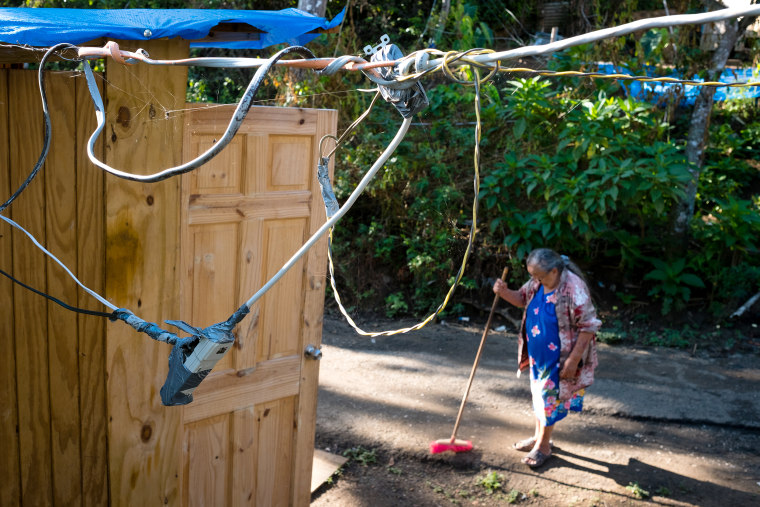Puerto Rico residents, who already pay almost twice as much for electricity as U.S. customers, are facing a 13 percent spike under an agreement government officials made to repay bondholders who own the debt of the island's bankrupt power authority.
The average residential household in Puerto Rico would start seeing an increase of approximately $11 per month by the summer of 2020, increasing costs to more than $130 a year, according to an analysis from the Institute for Energy Economics and Financial Analysis (IEEFA), a nonprofit that conducts research and analyses on financial and economic issues related to energy and the environment.
“This deal doesn’t acknowledge the fundamental reality that the Puerto Rico economy is declining,” Cathy Kunkel, an energy analyst at IEEFA, told NBC News. "I don’t understand how they expect people to pay for this."
These increased costs come as Puerto Rico continues to struggle to recover from the wallop Hurricane Maria delivered in 2017, resulting in the total collapse of the island’s power grid and the world's second-longest blackout.
“Nobody wants to pay more,” Esther Davila, a resident of Cayey, told NBC News in Spanish. “Especially when people’s paychecks remain the same.”
Rates are expected to gradually increase this year until fiscal year 2043 if the island’s legislature and bankruptcy courts approve the deal by the end of June.
In almost 25 years, Puerto Ricans would be paying almost $20 more a month than they pay now — up to about $220 more a year per household until bondholders are paid off.
Davila, who lives in a four-person household, currently pays around $150 a month for electricity. The rate hikes could increase her monthly bill to $170. In the United States, her family would have paid close to $85 a month.
According to Puerto Rico’s financial and fiscal authority, known as AAFAF, the debt repayment process could last more than four decades.
Puerto Rico has roughly $120 billion in debt and pension obligations. The power authority’s debt is $9 billion. The new agreement would reduce the utility’s debt by up to 32.5 percent.
IEEFA analysts estimate that, under the new deal, Puerto Ricans will pay more than $23 billion over the next 48 years, plus an additional $100 million to $200 million to cover the deal’s administrative expenses.
“This is a great deal for the consultants and the financial and legal counselors involved, not for Puerto Ricans,” Kunkel said.
This is not the first time Puerto Rico has tried to raise electricity costs to reduce the power authority's debt. Government officials rejected a 2016 debt restructuring plan they considered it to be too high a burden on the economy. At the time, the Puerto Rico Energy Commission noticed that the collection of extra fees imposed on Puerto Rican power customers was “not well regulated in the deal,” Kunkel explained.
But the new agreement does not seem to address such anguish.
“We don't see anything in the current deal suggesting that these concerns have been addressed or that Puerto Rico ratepayers are protected from excessive fees,” Kunkel added.
Multiple reports have also revealed that the bankrupt Puerto Rican government pays billions to lawyers, bankers and consultants for costs related to debt restructuring.
The electricity price hikes are part of an agreement reached May 3 among the government of Puerto Rico, most of the bondholders who own debt from the Puerto Rico Energy Power Authority (PREPA), major PREPA bond insurer Assured Guaranty and the Financial Oversight and Management Board (FOMB), which is the federally appointed board overseeing the island’s finances as it attempts to claw back from its crippling debt.
Christian Sobrino, CEO of AAFAF and a FOMB representative, praised the agreement in a press release announcing the deal, saying it “sends a strong message to the markets that our island is taking the necessary steps to restructure our public debt.”
José F. Ortiz, CEO of PREPA, agreed.
“The agreement is a significant step forward in getting PREPA out of bankruptcy,” Ortiz, an engineer, said.
Puerto Rico Gov. Ricardo Rosselló labeled PREPA’s debt restructuring as “critical” to creating a “client-centered energy sector that promotes investment and economic development on the island."
Manuel Laboy Rivera, Puerto Rico’s secretary of economic development, told NBC News last month that renewable energy is one of the key sectors the Rosselló administration is focusing on to fuel economic development in the island.
Yet the agreement would not exempt residents and businesses that elect to generate their own electricity by using solar panels from paying the power authority’s debt, a move that could deter people from switching to renewable energy at a time when almost 80 percent of Puerto Rico's energy comes from imported oil.
Under the deal, anyone who installs their own solar panels after Sept. 30, 2020, will be required to pay the additional charges based on both how much electricity they consume from the power authority’s grid and what’s produced by solar. But there’s an incentive for customers who are able to install renewable energy systems before then. They won’t have to pay extra debt fees for what they generated through solar for at least the next 20 years.
The deal comes amid negotiations to privatize the power authority, with transmission and distribution contracts with private companies expected to be in place next year.
As PREPA moves to privatization, Funkel said the agreement could potentially detract future investors.
“What this deal does is give priority to bondholders of existing debt, making it more risky for private investors to get involved,” she said.
FOLLOW NBC LATINO ON FACEBOOK, TWITTER AND INSTAGRAM.

